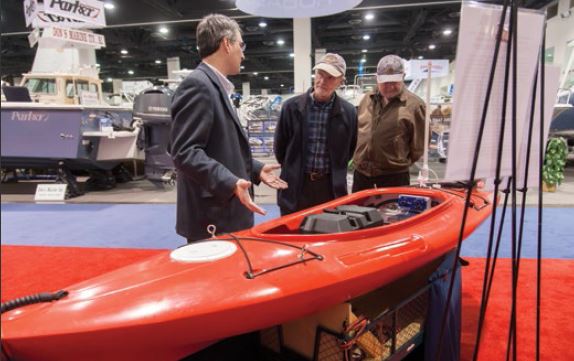Marine Robotics Provide New Platform for Gathering Data on Watershed Conditions

Dr. David C. Smith, Associate Dean for Academic Affairs and Professor of Oceanography, URI Graduate School of Oceanography, talks with visitors at the Feb. 2014 Providence Boat Show about a kayak being used in the Rhode Island NSF EPSCoR Track-2 project to help collect data from watersheds. Photo by Michael Salerno.
Marine robotics provide new platform for gathering data on watershed conditions
By Amy Dunkle
If you happen to see an unmanned kayak this fall, trolling a marsh in a monotonous pattern, don’t get alarmed. There is no eerie explanation — just the latest in marine robotics at work, tracking the content and quality of the Ocean State’s water.
“These are new platforms in our quiver of sampling tools,” said Dr. Chris Roman, Assistant Professor of Oceanography at the URI Graduate School of Oceanography. “We need more monitoring of such places to understand the ecosystem, but monitoring is expensive.”
In an effort to collect data less expensively, Dr. Roman is working on robotic systems known as autonomous surface vehicles, or ASVs, to gather critical information to help scientists better understand what is taking place and how natural resources cope with the affects of climate change.
He brings his marine robotics expertise to the three-state watershed study funded by the National Science Foundation (NSF) EPSCoR Research Infrastructure Improvement Track-2 program.
The joint project with Vermont and Delaware encompasses multiple disciplines of study, pairing Dr. Roman’s ocean engineering with hydrology, economics and chemistry.
The first year has focused on selecting and placing high tech sensors in watersheds and building economic models that will gauge how better monitoring information can impact decisions on water quality.
Dr. Roman said his unmanned kayak and an aerial drone (planned for the project’s third year) would augment the data being gathered by URI hydrologists Dr. Art Gold and Kelly Addy with the sensors placed in Middletown and Scituate watersheds.
The watershed sensors paint a comprehensive, long-term picture along with what occurs during certain events — such as a storm — that initiate runoff. Researchers also want to know what happens as such events filter through the salt marshes and run into Narragansett Bay. That’s where the ASVs play a vital role.
“The ASV goes out and samples the water,” Dr. Roman explained. “It’s good at doing repeated surveys. We give GPS positions and tell it to drive around in organized patterns, basically a mission with a bunch of waypoints. The ASV can do it for a long time and not get bored.”
An electric trolling motor propels the unmanned, 14-foot kayak using on board software that tells it where to go. The boat drags sensors through the water to measure various parameters such as temperature, salinity, pH, and turbidity. These can be used to map out the exit flow response to an extreme weather event. The idea is to look for the dynamic or changing aspects taking place within the water.
In the project’s third and final year, Dr. Roman said he planned to invest in an unmanned helicopter, similar to a drone, to carry out aerial photography of the watersheds to assess conditions such as water levels and water clarity.
The tools will allow scientists to track how much water filters through the watershed along with how potential pollutants get sequestered or flow through the salt marshes, which act as a buffer.
Together, the kayak and helicopter drone can provide an unparalleled view of exactly what is taking place in the watershed and Narragansett Bay. Dr. Roman said:
“The kayak is very good at making precision measurements. It can drive around in places that are otherwise hard to get to by boat, in a very repeated fashion better than a person can. The helicopter drone can get you fast access and aerial views of marsh that we otherwise can’t get to easily — marshes are hard to travel by foot, but very easy to fly over. There are also few obstructions and no people to bother, and we can quickly access at a relatively low cost.”
